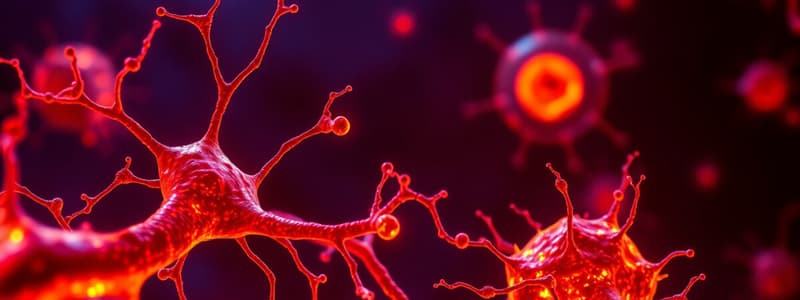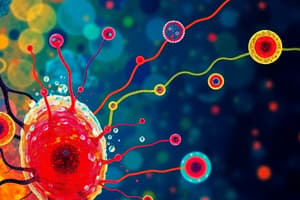Podcast
Questions and Answers
What is the primary role of cell signaling in multicellular organisms?
What is the primary role of cell signaling in multicellular organisms?
- To produce energy through the breakdown of complex molecules.
- To facilitate direct nutrient exchange between cells.
- To maintain a constant internal cellular environment despite external changes.
- To enable organismal development, tissue organization, activity coordination and control of growth and division. (correct)
How does cell signaling contribute to the survival of single-celled organisms?
How does cell signaling contribute to the survival of single-celled organisms?
- By facilitating sexual reproduction.
- By enabling them to form multicellular colonies.
- By increasing their size to resist predation.
- By allowing them to adapt to environmental changes. (correct)
What is the fundamental process of signal transduction?
What is the fundamental process of signal transduction?
- The synthesis of proteins within the cell.
- The transport of molecules across the cell membrane.
- The conversion of an extracellular signal into a cellular response. (correct)
- The replication of cellular DNA in response to environmental cues.
Why is signal transduction necessary for cells?
Why is signal transduction necessary for cells?
Which of the following is an example of an endogenous signal?
Which of the following is an example of an endogenous signal?
Epinephrine is an example of what type of chemical signal?
Epinephrine is an example of what type of chemical signal?
Which type of signaling involves a cell sending a signal to itself?
Which type of signaling involves a cell sending a signal to itself?
What is a key characteristic of plasma membrane-attached protein signaling?
What is a key characteristic of plasma membrane-attached protein signaling?
What allows cells to respond selectively to specific signals?
What allows cells to respond selectively to specific signals?
Why do cells need receptors to detect most signals?
Why do cells need receptors to detect most signals?
What event signifies receptor activation?
What event signifies receptor activation?
A ligand is also know as what?
A ligand is also know as what?
What are the three primary regions of a plasma membrane receptor?
What are the three primary regions of a plasma membrane receptor?
Which of the following is NOT a main class of plasma membrane receptors?
Which of the following is NOT a main class of plasma membrane receptors?
Where do intracellular receptors typically bind to signals?
Where do intracellular receptors typically bind to signals?
What is the significance of the allosteric site on a receptor?
What is the significance of the allosteric site on a receptor?
What effect does an increased presence of signaling molecules typically have on cellular response?
What effect does an increased presence of signaling molecules typically have on cellular response?
How does a higher affinity of a receptor for its signaling molecule affect the cellular response?
How does a higher affinity of a receptor for its signaling molecule affect the cellular response?
How does an antagonist work?
How does an antagonist work?
Which of the following mechanisms describes how competitive antagonists work?
Which of the following mechanisms describes how competitive antagonists work?
How do non-competitive antagonists inhibit receptor activation?
How do non-competitive antagonists inhibit receptor activation?
What is the main role of intracellular signal transduction pathways?
What is the main role of intracellular signal transduction pathways?
Which of the following is NOT considered a common intracellular transduction pathway?
Which of the following is NOT considered a common intracellular transduction pathway?
Why are second messengers important in signal transduction?
Why are second messengers important in signal transduction?
Which of the following is an example of a second messenger?
Which of the following is an example of a second messenger?
What is the purpose of second messengers in signal transduction pathways?
What is the purpose of second messengers in signal transduction pathways?
An example of a cellular response following receptor activation is?
An example of a cellular response following receptor activation is?
Following receptor activation, what are the main mechanisms that promote cellular changes?
Following receptor activation, what are the main mechanisms that promote cellular changes?
How are existing proteins typically modified to bring about cellular responses?
How are existing proteins typically modified to bring about cellular responses?
What role do protein kinases play in cellular signaling?
What role do protein kinases play in cellular signaling?
What is the function of protein phosphatases in cellular signaling pathways?
What is the function of protein phosphatases in cellular signaling pathways?
On which amino acids does phosphorylation typically occur?
On which amino acids does phosphorylation typically occur?
Which of the following is most likely to add phosphates to specific amino acids?
Which of the following is most likely to add phosphates to specific amino acids?
Which of the following statements accurately compares protein kinases and protein phosphatases?
Which of the following statements accurately compares protein kinases and protein phosphatases?
G-protein coupled receptors interact with what?
G-protein coupled receptors interact with what?
Which of the following describes how signalling works with G-protein coupled receptors?
Which of the following describes how signalling works with G-protein coupled receptors?
What is the immediate consequence of a ligand binding to its receptor?
What is the immediate consequence of a ligand binding to its receptor?
How does the extracellular domain of a plasma membrane receptor contribute to cell signaling?
How does the extracellular domain of a plasma membrane receptor contribute to cell signaling?
What distinguishes enzyme-linked receptors from other classes of plasma membrane receptors?
What distinguishes enzyme-linked receptors from other classes of plasma membrane receptors?
What is the role of the transmembrane domain in plasma membrane receptors?
What is the role of the transmembrane domain in plasma membrane receptors?
What is the primary function of intracellular receptors?
What is the primary function of intracellular receptors?
Why are some signaling molecules required to cross the plasma membrane to bind their receptors?
Why are some signaling molecules required to cross the plasma membrane to bind their receptors?
How does ligand binding influence the activity of G-protein coupled receptors?
How does ligand binding influence the activity of G-protein coupled receptors?
How is specificity achieved in cell signaling?
How is specificity achieved in cell signaling?
What role do second messengers play in intracellular signal transduction pathways?
What role do second messengers play in intracellular signal transduction pathways?
What effect does increased concentrations of a signaling molecule typically have on the cellular response?
What effect does increased concentrations of a signaling molecule typically have on the cellular response?
Which of the following is a mechanism by which cells modify existing proteins to bring about cellular responses?
Which of the following is a mechanism by which cells modify existing proteins to bring about cellular responses?
What is the difference between protein phosphatases and protein kinases?
What is the difference between protein phosphatases and protein kinases?
What amino acids are most commonly targeted by protein kinases during phosphorylation?
What amino acids are most commonly targeted by protein kinases during phosphorylation?
Which cellular response to activation of a receptor directly involves changes in gene expression?
Which cellular response to activation of a receptor directly involves changes in gene expression?
How do signals act in paracrine signaling?
How do signals act in paracrine signaling?
For a plasma membrane receptor, which region is directly associated with enzymes or other proteins that help propagate the signal?
For a plasma membrane receptor, which region is directly associated with enzymes or other proteins that help propagate the signal?
If a signaling molecule is unable to cross the plasma membrane, what type of receptor would it most likely interact with?
If a signaling molecule is unable to cross the plasma membrane, what type of receptor would it most likely interact with?
Which of the following is a direct effect of the conformational change in a receptor following ligand binding?
Which of the following is a direct effect of the conformational change in a receptor following ligand binding?
How does signal amplification occur through second messengers?
How does signal amplification occur through second messengers?
What is the consequence of a cell having a greater number of receptors on its surface?
What is the consequence of a cell having a greater number of receptors on its surface?
How do competitive antagonists affect the cellular response to agonists?
How do competitive antagonists affect the cellular response to agonists?
Non-competitive antagonists can decrease the cellular response to agonists. What is a mechanism by which this occurs?
Non-competitive antagonists can decrease the cellular response to agonists. What is a mechanism by which this occurs?
How does phosphorylation modify the function of target proteins in cell signaling pathways?
How does phosphorylation modify the function of target proteins in cell signaling pathways?
Protein kinases exhibit specificity. How does this specificity contribute to regulation of cell function?
Protein kinases exhibit specificity. How does this specificity contribute to regulation of cell function?
What role does the autocrine signaling play in a cellular environment?
What role does the autocrine signaling play in a cellular environment?
What are the common components in intracellular transduction pathways?
What are the common components in intracellular transduction pathways?
How does activation of protein kinases occur?
How does activation of protein kinases occur?
Which of the following statements best describe the role of endogenous signals?
Which of the following statements best describe the role of endogenous signals?
The cellular response to receptor activation is influenced by what factors?
The cellular response to receptor activation is influenced by what factors?
What would happen to an organism if cells communicate with each other ineffectively?
What would happen to an organism if cells communicate with each other ineffectively?
How does the affinity of receptor for signaling molecule impact the cellular response?
How does the affinity of receptor for signaling molecule impact the cellular response?
What is the initial step in cell-surface receptor activation?
What is the initial step in cell-surface receptor activation?
How are the activities of many kinases and phosphatases regulated?
How are the activities of many kinases and phosphatases regulated?
What is the role that transduction pathways play in cell signalling?
What is the role that transduction pathways play in cell signalling?
Which of the following signal transmissions utilizes direct contact?
Which of the following signal transmissions utilizes direct contact?
What is a key characteristic of cells that can respond to a certain signal?
What is a key characteristic of cells that can respond to a certain signal?
Which statement accurately describes the characteristics of ligands?
Which statement accurately describes the characteristics of ligands?
What results from protein phosphorylation?
What results from protein phosphorylation?
What role does cell signalling play in multicellular organisms?
What role does cell signalling play in multicellular organisms?
Why do we need receptors?
Why do we need receptors?
Flashcards
Signal transduction?
Signal transduction?
The conversion of an extracellular signal into a cellular response.
Endogenous signals
Endogenous signals
Signals that originate from within an organism.
Endocrine signalling
Endocrine signalling
A type of signaling where molecules, called hormones, are released into the bloodstream and can access distant target cells.
Paracrine signaling
Paracrine signaling
Signup and view all the flashcards
Autocrine signaling
Autocrine signaling
Signup and view all the flashcards
Plasma membrane-attached protein signalling
Plasma membrane-attached protein signalling
Signup and view all the flashcards
Why do we need receptors?
Why do we need receptors?
Signup and view all the flashcards
Ligand
Ligand
Signup and view all the flashcards
Receptor activation
Receptor activation
Signup and view all the flashcards
Receptors are:
Receptors are:
Signup and view all the flashcards
Plasma membrane receptor
Plasma membrane receptor
Signup and view all the flashcards
Plasma membrane receptors
Plasma membrane receptors
Signup and view all the flashcards
Three main classes of plasma membrane receptors?
Three main classes of plasma membrane receptors?
Signup and view all the flashcards
G-protein coupled receptors
G-protein coupled receptors
Signup and view all the flashcards
Ligand gated ion channel
Ligand gated ion channel
Signup and view all the flashcards
Small molecules produced following receptor activation.
Small molecules produced following receptor activation.
Signup and view all the flashcards
Examples of second messengers?
Examples of second messengers?
Signup and view all the flashcards
Purpose of second messengers
Purpose of second messengers
Signup and view all the flashcards
Cellular responses
Cellular responses
Signup and view all the flashcards
Main mechanisms that promote changes in cells?
Main mechanisms that promote changes in cells?
Signup and view all the flashcards
How to modify existing protein?
How to modify existing protein?
Signup and view all the flashcards
Phosphorylation
Phosphorylation
Signup and view all the flashcards
Dephosphorylation
Dephosphorylation
Signup and view all the flashcards
Phosphorylation function?
Phosphorylation function?
Signup and view all the flashcards
Study Notes
Overview of Cell Signaling
- Cells are in constant communication with each other and their environments.
- Cells must be able to detect and respond to appropriate signals.
- Cell signalling is essential for organismal development, tissue organization, coordination of activities, and control of growth and division in multicellular organisms.
- Single-cell organisms require cell signalling to adapt to environmental changes.
Signal Transduction
- Signal transduction converts an extracellular signal into a cellular response.
- Cells adapt to changes in their function or structure by signal transduction.
Types of Signals
- Common signal types include chemical, physical, endogenous (internal), and exogenous (external) signals.
- Endogenous signals are generated internally and include endocrine, paracrine, autocrine, and plasma membrane-attached protein signals.
- Exogenous signals originate outside the organism and include photons of light, odors, medications, and invading microorganisms.
Endogenous Chemical Signals
Endocrine Signaling
- Uses hormones that are released into the bloodstream.
- Hormones access distant target cells, examples include insulin and epinephrine.
Paracrine Signaling
- Signal is released by a nearby cell onto a target cell.
- It creates a gradient of signalling molecules like neurotransmitters and growth factors.
Autocrine Signaling
- An autocrine signal acts on the cell that released it.
- Includes cytokines and certain growth factors.
Plasma Membrane-Attached Protein Signaling
- Signaling molecules embedded in the plasma membrane of one cell activate receptors on another cell through direct contact.
- Molecules may also be cleaved from the membrane to become soluble signals.
- Adhesion molecules on immune cells are an example.
Cellular Receptors
- Receptors facilitate specific signal selectivity.
- They enable graded responses based on the signal amount.
- The same signal may produce different responses across different cell types.
- Receptors amplify signals.
- Most signals need plasma membrane receptors to initiate intracellular responses because they cannot cross the plasma membrane.
Receptor Function
- Ligands or agonists bind to receptors, where a ligand is any molecule that binds, and an agonist is a ligand that activates the receptor.
- Receptor activation involves a conformational change signaling the presence of a ligand.
Key Properties of Cellular Receptors
- Cells respond to signals only with the appropriate receptor.
- Receptors are proteins sensitive to and physically interacting with signals.
- A ligand is a molecule that can tightly bind to and activate a receptor; it is also known as a receptor agonist.
Signal Binding and Cellular Changes
- Ligand binding causes the receptor to undergo a conformational change, activating an intracellular transduction pathway.
- This conformational change leads to the enzymatic activity of the receptor, the opening of pores for ion flow, the activation of a bound kinase, or the activation of a G-protein.
Plasma Membrane Receptors
- Detect signals that cannot cross the plasma membrane.
- These receptors have three regions:
- An extracellular domain that binds signal molecules, possessing a specific binding site.
- A transmembrane domain embedded in the plasma membrane which transmits signals.
- An intracellular domain typically associated with enzymes or proteins that help transduce the signal which then activates signaling.
Plasma Membrane Receptor Classes
- G-protein coupled receptors.
- Ligand-gated ion channels.
- Enzyme-linked receptors.
G-Protein Coupled Receptors
- The receptor interacts with a heterotrimeric G-protein.
- Ligand binding causes the G-protein to dissociate from the receptor.
- Activated G-proteins interact with intracellular targets to regulate cell function.
Ligand-Gated Ion Channels
- Ligand binding to the receptor causes the opening of a pore.
- Ions flow freely through this pore.
Enzyme-Linked Receptors
- The receptor either has intrinsic enzyme activity or associates with an enzyme.
- Ligand binding to the receptor causes enzyme activation.
Intracellular Receptors
- Intracellular Receptors can detect signaling molecules that have crossed the plasma membrane, such as steroids and thyroid hormones.
- They typically regulate gene expression.
Ligand Binding
- Ligands bind to the receptor's binding site through numerous weak, non-covalent interactions.
- Affinity is the strength of interaction between a ligand and its receptor, and specificity is the receptor’s ability to discriminate between different ligands.
- Molecules binding to an allosteric site can modify the degree of receptor activation by a ligand.
Factors Affecting the Magnitude of Cellular Response
- Amount of signalling molecule: response increases with concentration.
- Affinity of receptor: Higher affinity leads to response at lower dosage.
- Receptor expression: increasing numbers of receptors leads to increased maximal response.
- Presence of Competitive Antagonists: Compete with agonists, increasing the required agonist concentration for desired effect.
- Presence of Non-Competitive Antagonists: Binds to allosteric site or irreversibly to the binding site, inhibiting the receptor.
Intracellular Signal Transduction Pathways
- Receptor activation doesn't directly change cell function; proteins or small molecules transduce the signal.
Common Pathways
- Second messenger systems.
- Protein phosphorylation/dephosphorylation.
- GTP-binding proteins.
Second Messengers
- Small molecules that are produced following receptor activation.
- Examples: cAMP, Ca2+, IP3, DAG, cGMP.
- Second messengers amplify signal, transmit signal from plasma membrane to cytosol, and activate targets to propagate the signal.
Cellular Responses
- Examples: Proliferation, apoptosis, contraction, secretion, movement, differentiation, and altered metabolism.
- Main mechanisms: modification of existing proteins and changes in gene expression.
- Modification of existing proteins can occur via phosphorylation/dephosphorylation, binding to second messengers, binding to nucleotides, or binding to upstream signalling proteins that then alter the target protein's conformation.
Phosphorylation/Dephosphorylation
- Protein phosphorylation refers to adding a phosphate group to a protein, performed by protein kinases.
- Protein dephosphorylation refers to removing a phosphate group, performed by protein phosphatases.
- Phosphorylation modifies the function of the target protein, modifies enzyme activity, generates binding site for additional protein, and causes protein dimerization.
- Phosphorylation typically occurs on tyrosine, serine, and threonine amino acids, and provides molecular memory of pathway activation.
Protein Kinases
- Protein Kinases may be cytosolic, intrinsic to a receptor, or attached to a receptor.
- They add phosphates to specific amino acids.
- Tyrosine kinases vs. serine/threonine kinases are examples
- They are directed to a phosphorylation site by the surrounding amino acid sequence.
- Protein Kinases phosphorylate more than one target protein.
- Proteins can have multiple phosphorylation sites which allows for complex regulation of function.
- Protein Kinases are directly activated after ligand binding to a receptor.
- Receptor tyrosine kinases can also be under the control of second messengers. An example being protein kinase A.
Protein Phosphatases
- Protein Phosphatases exhibit specificity like protein kinases.
- They remove phosphate groups from specific amino acids like tyrosine or serine/threonine.
- Protein Phosphatases dephosphorylate specific substrates.
- Kinases and phosphatases are regulated through phosphorylation.
Studying That Suits You
Use AI to generate personalized quizzes and flashcards to suit your learning preferences.




